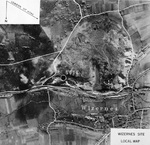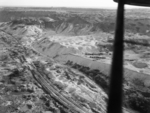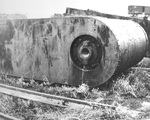La Coupole
| Type | 251 Other | |
| Historical Name of Location | Wizernes, Nord-Pas-de-Calais, France | |
| Coordinates | 50.705830000, 2.243889000 |
Contributor: Alan Chanter
ww2dbaseWhile the German Wehrmacht had expressed a preference for mobile launchers for their Vergeltungswaffe (retribution weapon) rockets as oppose to the building of large heavily fortified complexes there was a problem in making enough of the important cryogenic liquid-oxygen fuel close by, which made mobile preparation of the rockets far more difficult. Adolf Hitler therefore insisted that static V2 launch sites should be constructed to the same standard of resilience as the U-boat and S-boat pens which had been built along the Atlantic coastline.
ww2dbaseIn March 1943 work commenced on a huge 22-metre high V2 bunker Blockhaus d'Éperlecques near Watten in the Pas-de-Calais department in Northern France, but before it could be completed British Royal Air Force (RAF) photo-reconnaissance and the efforts of local resistance groups succeeded in establishing the possible intention of this new structure, and on 27 August 1943, 187 B-17 aircraft from the US 8th Air Force delivered a devastating attack which rendered the site inoperable, although for a while part of the facility was briefly used to produce the liquid fuel for the V2 rockets.
ww2dbaseWork on a vast alternative bomb proof facility began in October 1943. Barely eight miles away and located in a large worked-out chalk quarry near the town of Wizernes, south-west of Saint-Omer. Work commenced with the digging of a circular trench, 84 metres in diameter in to which would sit a 5-metre thick cupola weighing 55,000 tons, 71 metres in diameter, to provide protection from bombing for the octagon rocket preparation area, 41 metres in diameter, which would be built beneath. In addition some seven kilometres of tunnels were to be dug into the chalk walls of the quarry to provide workshops, storerooms, fuel supplies, a liquid oxygen (LOX) manufacturing plant, generators, barracks, offices and a hospital. As additional protection to prevent bombing from undermining the structures integrity the dome was surrounded by a 2-metre thick bomb-proof "skirt" (Zerschellerplatte) of steel reinforced concrete. A large number of Westphalian miners supported by some 1,300 compulsory French workers and 500 Russian prisoners were brought in to complete the work. In total a million tons of concrete would be needed to build the facility.
ww2dbaseThe unprepared rockets arrived by rail from Nordhousen, the infamous factory tunnelled deep under the 1,099-foot high Kohnstein mountain where slave labourers, beaten and abused by their SS guards worked to construct the deadly Vergeltungswaffe weapons. The rockets were unloaded at the "Domes" railway station, located on a siding that connected to the Saint-Omer-Boulogne main line. Taken into the octagon to receive their alcohol and liquid oxygen fuel (produced on the site), and fitted with their 943-kilogram Amatol (a 60/40 TNT and Ammonium nitrate mix) warheads, the rockets would then be moved outside through two high tunnels ("Gustav" and "Gretschen") to external launching pads. The 12.5-ton rockets needed to be fired within 48 hours of fuelling to avoid the liquid oxygen from damaging vital interior parts. Once completed, the Germans intended to launch, from here, fifteen rockets against London, England, United Kingdom daily.
ww2dbaseThe Allies response
ww2dbaseIn November 1943 the RAF's Photographic Interpretation Unit (PIU) at Danesfield House (q.v.) became aware of the construction work that had begun near Wizernes. Images obtained from a photo-reconnaissance flight by a Spitfire aircraft on 4 March 1944 revealed concrete mixing was being conducted under camouflage netting beside the railway. From these photographs an intelligence report concluded that the site might possibly be intended for the launching of a large rocket against London and the south-east of England. Added to the list of priority targets (designated as "Special Military Construction XI/A/9" by the Allies) there now followed a series of sixteen air raids (Operation Crossbow) between 11 March and 20 July by both US and RAF heavy bombers which, while not damaging the main building, turned the surrounding area into a crater-packed landscape reminiscent of a World War I battlefield.
ww2dbaseWith construction of the facility barely impeded by the bombing, the RAF's 617 "Dambusters" Squadron, under the command of Group Captain Leonard Cheshire, was tasked with using its specially adapted Lancasters to deliver 12,000-pound "Tallboy" deep penetration bombs on the Wizernes site. On 24 June, after two previous attempts had been aborted through dense cloud over the target, Cheshire led sixteen Tallboy-carrying Lancaster bombers, equipped with the new "Stabilised Automatic Bomb Sight (SABS) Mk2A device" and two target-marking Mosquito fighter-bombers against the "Dome". At the target Cheshire, in one Mosquito aircraft, found that he was unable to release either his four smoke bombs or two red "Spotfire" target indicators (TIs). Fortunately the second Mosquito, piloted by Flight Lieutenant G. E. Fawke, dropped all of its TIs successfully in a dive from 17,000 to 6,000 feet. The Lancaster bombers now came in to release their bombs from altitudes varying between 16,300 to 17,500 feet (the bombs needed to be dropped from high altitude in order to build up the necessary velocity to penetrate the bomb-proof construction). One Lancaster, DV403, was shot down (of the four survivors one died later from his injuries) but fifteen massive "Tallboy" bombs rained down on the site - some landing virtually on top of each other causing extensive damage to buildings, roads and railway lines - and two bombs were seen to strike alongside the south-western edge of Wizernes huge concrete dome.
ww2dbaseCheshire's successor at No. 617 Squadron, Wing Commander James "Willie" Tait, flying a Mustang III fighter, would take the squadron back to Wizernes again on 17 July 1944. Finding haze and cloud making identification tricky, he had to dive down to 500 feet in order to mark the target accurately with two red "Spotfires". He was followed by a Mosquito aircraft which also conducted marking from 3,000 feet. Tait's Mustang sustained some light flak damage but returned safely. The lead Lancaster I (Special) was DV385, whose crew claimed on their return to Woodhall Spa to have made a direct hit from 17,900 feet on the north-west corner of the dome at 1236 hours, dislodging it and breaking off significant parts of the quarry cliff below, blocking one of the main tunnels. Later examination revealed that no bombs had actually hit the "Dome" but they had so disrupted the whole hillside, undermining the main structures, that it put pay to any more construction work and effectively stopped the launching of any V-2s from the complex.
ww2dbaseDespite their apparent success, No. 617 Squadron, led by Tait in his Mosquito aircraft, despatched fifteen Lancaster bombers to Wizernes again on the night of 20 July causing further damage to the complex. This followed an earlier raid by 104 other Lancaster bombers which had dropped a total of 1,524 bombs. A second mission was aborted through adverse weather over the target and 617's Lancasters returned home with their bombs unused.
ww2dbaseOne part of the complex that was never attacked was the "Leitstrahlbunker" about six miles down the road at Roquetoire, a sturdy structure 35 meters by 22 meters and 7 meters high, which the Germans planned to house a radio beam guidance system for the V2s in flight. This remained the sole undamaged "Heavy Crossbow" bunker installation remaining in France.
ww2dbaseAs Allied troops advanced into the Pas-de-Calais area (St. Omer was liberated by the 1st Polish Armoured Division) the Wizernes facility was abandoned by the Germans and, in September 1944, a Technical Inter-Service s Mission led by Colonel T.R.B. Sanders was able to examine the deserted site to finally confirm its intended purpose.
ww2dbaseLa Couplole Museum
ww2dbaseThe quarry reverted to private ownership after the war. The abandoned site with its octagon and tunnels was sealed off with ceiling to floor barricades and for many years it would remain in almost the same condition as it had in 1944, with sections of rusting railway track still in place. Only the hospital section remained relatively intact and was used by the local gendarmes as a shooting range. After many years a proposal was made to turn the site into a museum dedicated to commemorating the many French and Russian labourers who had died to build it. After a decade of work the La Coupole (Dome) museum opened to the public in May 1997 with both a V1 and V2 as exhibits. The La Coupole museum is open all year round, and its numerous aims remain a powerful reminder of both Nazi Germany's Vergeltungswaffe programmes and Allied efforts to destroy them.
ww2dbaseSources:
David Halford: "Target: Wizernes" (Aeroplane, May 2018)
Youtube: "V2 Rocket Factory"
National Geographic Channel: "Nazi Megastructures: V2 Rocket"
Wikipedia: "La Coupole"
Last Major Update: Mar 2020
La Coupole Mapa Interativo
Photographs
 |  |  |  |
La Coupole Timeline
| 27 Aug 1943 | 187 B-17 aircraft of US 9th Air Force attacked the German V2 bunker Blockhaus d'Éperlecques near Watten in Nord-Pas-de-Calais, France, redering the site mostly inoperable. |
| 4 Mar 1944 | A British photo-reconnaissance flight by a Spitfire aircraft revealed concrete mixing was being conducted under camouflage netting beside the railway near Wizernes in northern France, and it was later determined that the site might possibly be intended for the launching of a large rocket. |
| 18 Jun 1944 | British No. 617 Squadron attacked the 20-foot thick concrete dome containing V-2 rockets at Wizernes, France without success. They would return to this target on multiple occasions in the following month. |
| 24 Jun 1944 | British No. 617 Squadron attacked the 20-foot thick concrete dome containing V-2 rockets at Wizernes, France with "Tallboy" bombs. The bombs caused extensive damage to buildings, roads and railway lines. |
| 17 Jul 1944 | Bombers of British No. 617 Squadron attacked the German V2 rocket site at Wizernes, France. |
| 20 Jul 1944 | Bombers of British No. 617 Squadron attacked the German V2 rocket site at Wizernes, France. |
Você gostou deste artigo ou achou este artigo útil? Se sim, considere nos apoiar no Patreon. Qualquer valor já vai ajudar! Obrigado. Por favor, ajude-nos a divulgar o site: Fique atualizado com WW2DB: |

Wizernes, Nord-Pas-de-Calais, France
Latitude-Longitude:
50.7058, 2.2439
- » 1,178 biografias
- » 337 eventos
- » 45,089 entradas na linha do tempo
- » 1,245 navios
- » 350 modelos de aeronaves
- » 207 modelos de veículos
- » 376 modelos de armas
- » 123 documentos históricos
- » 261 instalações
- » 470 eventos
- » 28,488 fotos
- » 365 mapas
Joachim von Ribbentrop, German Foreign Minister, Aug 1939
Por favor, considere nos apoiar no Patreon. Mesmo R$1 por mês já faz uma grande diferença. Obrigado!
Ou, por favor, nos apoie adquirindo alguns produtos do WW2DB na TeeSpring. Obrigado!